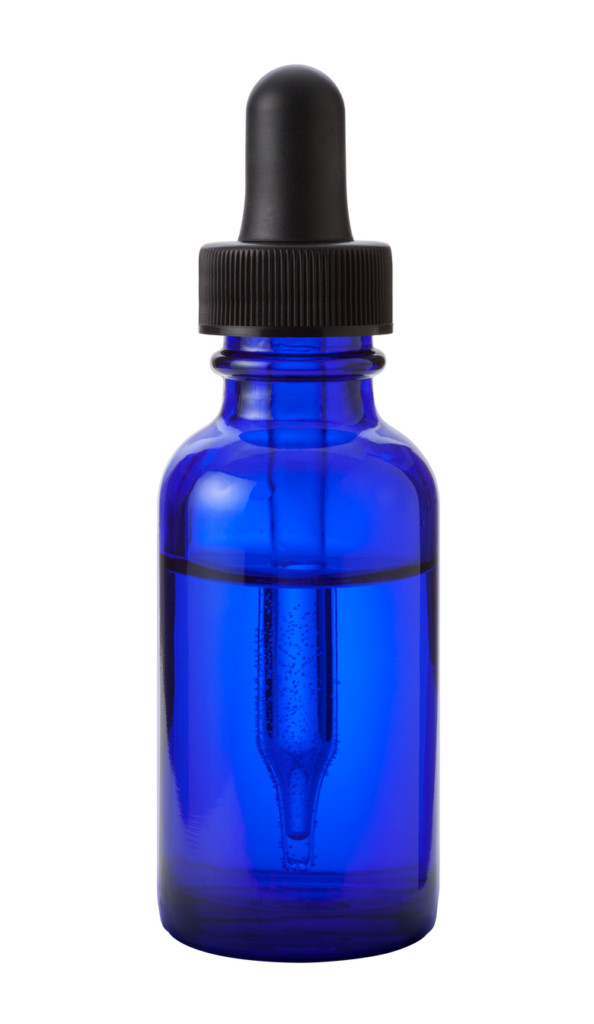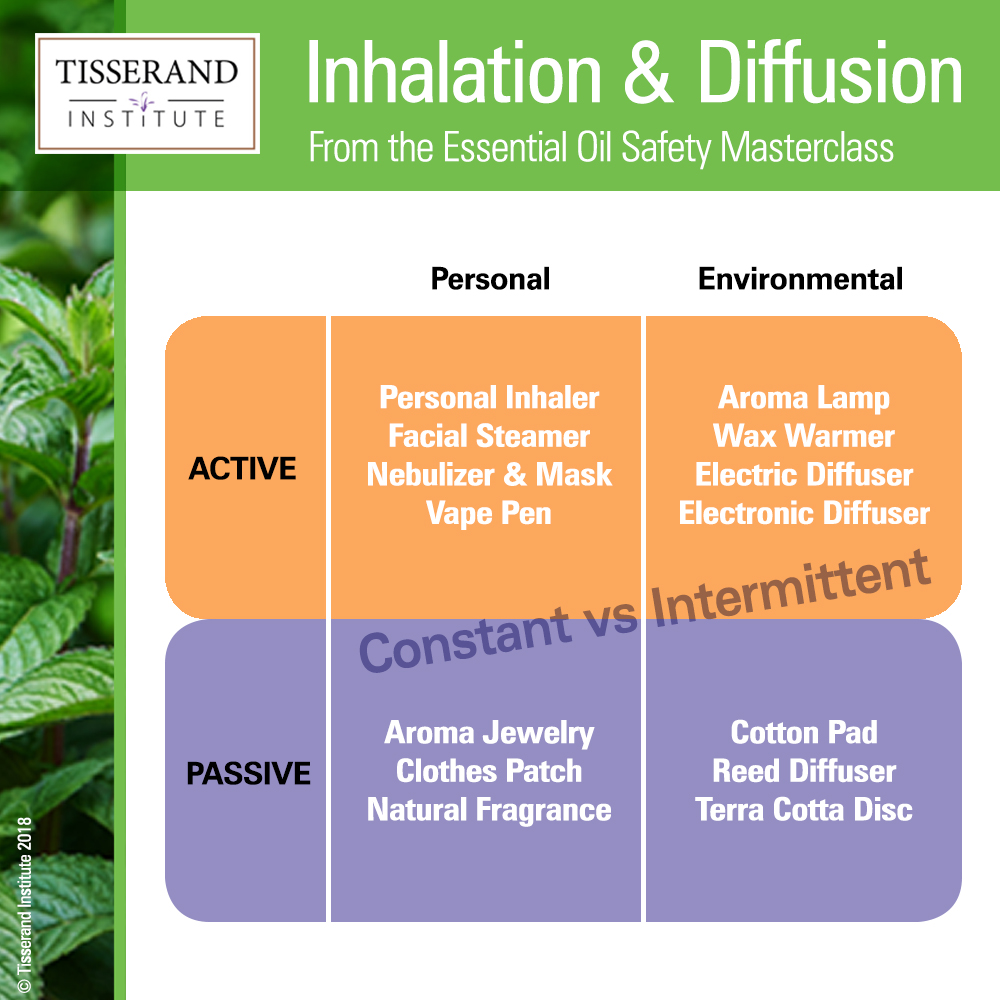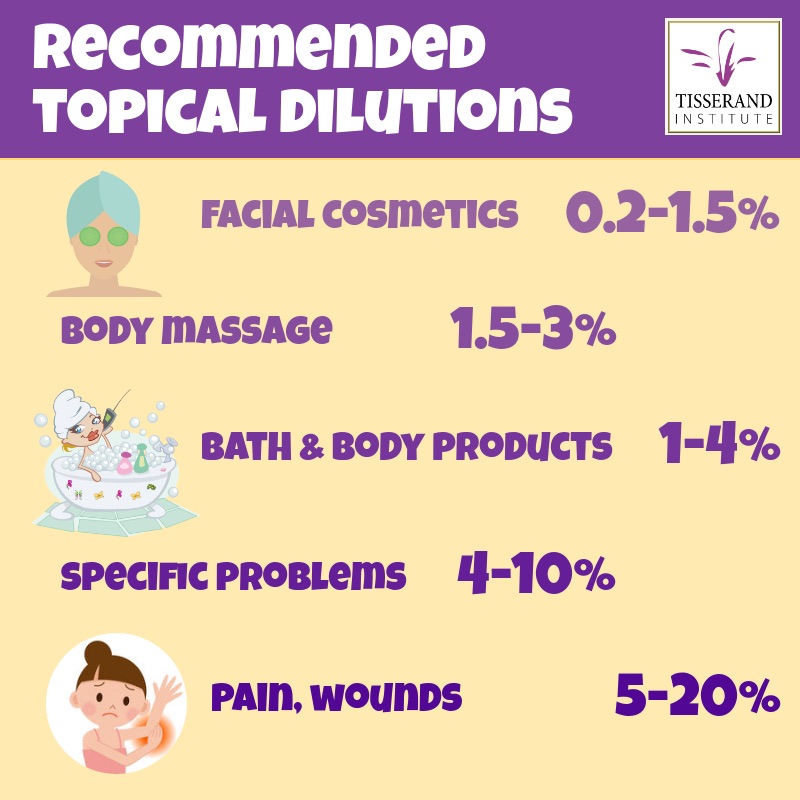by Rachel Andorfer
There are several ways that essential oils are commonly used therapeutically: diffusion (inhalation), topical (skin) application, baths, and oral ingestion. In this post I’ll go into detail about each method, how it works, and important safety tips.
Diffusion
Diffusion describes the process of dispersing essential oil molecules into the air so that they can be inhaled. Diffusion works because when you inhale essential oils you’re doing more than simply smelling them. When you inhale essential oils, molecules of essential oil make their way into your olfactory system and lungs where they can be absorbed into your bloodstream. The bloodstream then carries these molecules to the rest of your body where they can interact with cells and other molecules in your body to cause an effect. Diffusion is most often used for mood modulation such as energizing or reducing anxiety, and it can also be used to directly address respiratory issues.
There are several different types of diffusion: simple evaporation, steam, ultrasonic diffusion, atomization, and heat.
Simple evaporation is just that: allowing the essential oil to ‘passively’ evaporate (ie with no heat or other mechanism) into the air. You can put a few drops of essential oil on a cotton ball and then inhale from the cotton ball, you can use a reed diffuser set, or you can simply put a few drops of essential oil on an aromastone (often a porous lava stone or clay). Sometimes these stones are made as jewelry, and there are other types of aromatic pendant too.
Personal Diffusers
Personal diffusers are great for taking on-the-go and for not filling a whole room with vapor. This can be helpful if you’re not a huge fan of the scent of certain oils, or if you’re in a public space. I often see people recommending bringing a small diffuser to your desk at work, but I find this practice inconsiderate of coworkers who may have allergies or sensitivities, or may simply not enjoy the smell or effect of your essential oils.
One type of personal diffuser, sometimes called a personal inhaler or aroma-stick, uses a wick that is soaked in essential oil inside a plastic or metal tube. This tube is then inserted into the nose as you sniff, and the essential oil molecules enter the olfactory and respiratory systems.
Vape pens are another type of personal diffuser that use heat to diffuse essential oils quickly and on demand. In these devices, essential oils are stored in the chamber of a pen-shaped diffuser and a very short burst of heat is applied when the device is used to allow the user to inhale vaporized essential oil. Vape pens are generally safe in terms of essential oil content, but the safety of the vaporized base material used in the devices (usually glycerin and/or propylene glycol) is still uncertain.
Steam Inhalation
Steam inhalation is a process where essential oil is mixed with water that is then heated until it steams. This can be done with a dedicated facial steamer type device, or with the traditional bowl of hot water. For this, you lean over and inhale the steam while covering your head and the bowl with a towel. This method will diffuse more of the essential oil than simple evaporation, but some people cannot tolerate the steam, and caution must be exercised to ensure you don’t burn your face or irritate your eyes and nose with the essential oil vapors.
Ultrasonic Diffusion
Ultrasonic diffusion is perhaps the most popular active diffusion method, and ultrasonic diffusers are widely available. Drops of essential oil are added to a reservoir of water which the diffuser then agitates using ultrasonic sound waves. This agitation disperses the essential oil and water into the air, making it available for inhalation. This method is generally very reliable and low risk, although the cost of an ultrasonic diffuser may be a road block for some.
Atomization
Atomization is another quite popular diffusion method. It requires an atomizer that is generally available for purchase from essential oil retailers, although these are not as common as ultrasonic diffusers. Atomizers work by using a jet of pressurized air to disperse essential oil into the air without the use of water. This is also a reliable and safe method, but it does tend to use more essential oil at a time than ultrasonic diffusion, so it may not be optimal if you’re trying to conserve your essential oils.
Topical Application
Topical application refers to the process of applying essential oils to the skin. Occasionally this is done neat (undiluted), but it is always much safer to dilute essential oils in a carrier (vegetable) oil, such as olive or coconut, or other base before applying to the skin. Other bases would include lotion, gel, or high proof alcohol if making a fragrance.
Applying essential oils to your skin can work in two ways. First, and most obviously, this is the ideal way to address skin problems, or to assist in wound healing. Secondly, essential oils can absorb through your skin and either have an effect on the local tissue or absorb all the way into the bloodstream where it can be carried to the rest of the body. Often it is recommended to apply essential oils to wrists and temples, and this is due to the arteries that exist close to the surface of the skin in these areas which can make it easier to get the essential oils into the bloodstream.
Diluting an essential oil simply means mixing a small amount of essential oil with a larger amount of inert carrier oil. Dilutions are described in terms of percent essential oil. So a 1% dilution means you have a solution that is 1% essential oil and 99% carrier oil. You can download a full dilution chart here.
Even if an essential oil can be safely used without dilution, this is often only in the short term and is rarely necessary for therapeutic effect. Adverse reactions to undiluted essential oils can include hives (blistered rash), redness, itching and burning, and it’s difficult to predict who will have these adverse reactions. I recommend always diluting your essential oils, both for safety and for cost-effectiveness. Read more about the safety considerations here.
Baths
Aromatherapy baths are common practice and can combine some features of both topical application and diffusion. Before adding to the bath, essential oils need to be mixed in a carrier oil or other dispersant – and note that epsom salts and full-fat milk do not safely disperse essential oils – see this page for details. When you’re in the bath, some essential oil will be absorbed through your skin and some of it will evaporate into the air. Many people find that this sensory immersion in essential oils is an especially therapeutic experience.
However, it’s important to keep in mind that improperly dispersing your essential oils can lead to safety issues. Since essential oils are not soluble in water, the bath water cannot be expected to safely dilute your essential oils. Using a dispersant such as a carrier oil, as discussed above, is paramount to preventing adverse reactions to undiluted essential oils.
Oral Ingestion
Oral ingestion is the process of consuming an essential oil by mouth. This is one of the most controversial topics in aromatherapy due to safety considerations. Oral ingestion is different than the methods described above because there is more of a sudden impact on both the stomach and the liver, which metabolizes (chemically changes) the essential oil. Another issue is contact with the mucous membranes of the mouth and throat. Essential oils could irritate these delicate membranes causing sometimes severe discomfort.
Do not ingest essential oils in water. This increases the risk of gastric irritation, and makes it more difficult for your body to efficiently absorb the essential oil. (Contrary to popular myth, essential oil ingestion in water is not used in France.) Instead, essential oils can be added to capsules, along with some vegetable oil, and swallowed like pills. These are either regular gelatin capsules or they are enteric-coated capsules. Capsules with an enteric coating will protect the essential oil inside the digestive tract longer than non-enteric-coated, allowing it to be absorbed further down in the intestines. The type of capsule used will depend on the essential oil and the purpose of use.
There are commercial preparations containing essential oils such as peppermint that are used to address digestive issues or intestinal issues such as bloating and irritable bowel. These are safe to use as directed. Due to the potential complications of ingestion (gastric upset, drug interactions, liver toxicity, safety in pregnancy…), I strongly recommend seeking the guidance of a healthcare professional with relevant experience and credentials before ingesting essential oils.
Essential oil safety
Essential oils are extremely concentrated substances, often requiring hundreds of plants to create a single bottle. Due to their high concentration, essential oils must be treated with care.
Each essential oil has specific safety considerations, but here I will address those that apply across all essential oils. Please do the proper research before using any essential oil to discover any unique precautions to take.
- In general, essential oils should be applied to the skin at a maximum of about 1 or 2% dilution to avoid irritation. There are special considerations for many oils here, as well as special instructions for applying to children or those with sensitive skin. You can check this dilution chart for a good starting place.
- Anyone can have an allergy to any essential oil, so I recommend that you test any new essential oils (properly diluted) on a small patch of skin and watch for redness and irritation over 24 hours.
- Oral ingestion is particularly risky, so I recommend only using this method if you’ve been through a safety class that addresses oral ingestion or are under the care of a healthcare professional with appropriate training.
- Check for interactions with medication before using any essential oil.
- Pregnant or nursing women should be cautious when using essential oils, using lower dilutions and avoiding some oils entirely.
- Do NOT use plastic containers for essential oils or blends; instead choose glass bottles (preferably dark glass) and steel roller balls.
- Store essential oils in a cool, dark place in a well-sealed container. Exposure to UV light, heat, or oxygen can accelerate the degradation process, damaging your essential oils and breaking them down, essentially causing them to ‘spoil’ faster.
How to decide which method to use?
Now that you know about the various ways you can use essential oils, how do you decide which one is best for you? That depends on what your goal is – what are you using the essential oils for. Skin application is best for addressing issues of the skin, any form of inhalation is most appropriate to help with mood and psychological issues, or to ease respiratory problems.
Whatever the reason you are reaching out to them at this moment, one of the most wonderful things about essential oils is their versatility. This means you can use them in the most suitable way for your needs, maximizing benefits while minimizing risks. Most of the time, dilution is the key!
Go here to read Part 1 of the Beginner’s Guide






Clear and concise, good info
i love what Rachel has been teaching and sharing. it has helped me begin my essential oil journey. it made me independent of networks and what network members talked about and suggested. i became more critical in choosing the oils apart from the network that sells at exorbitant prices. so thank you Rachel.
Doterra say You can ingest some of their oils for instance lemon oil in water? And oregano or basil in cooking. Is this false and is thus harmful?
Ingesting any essential oil in water is not very sensible – see the paragraph on Oral Ingestion in this post. You can use essential oils in cooking, though most of the time one drop is either enough or too much.